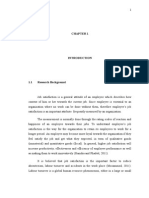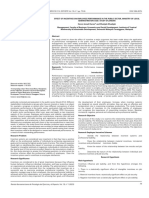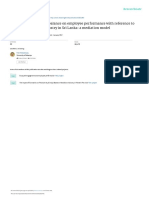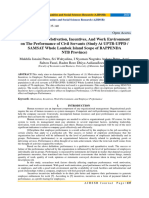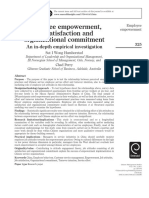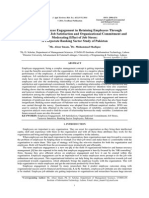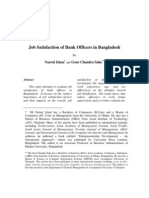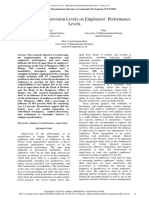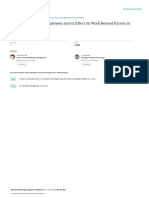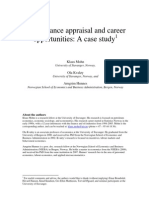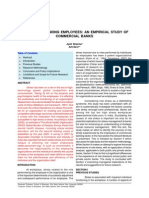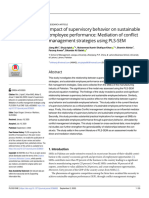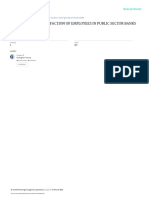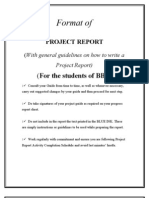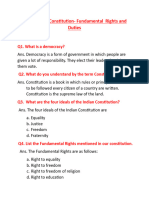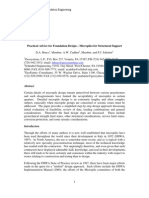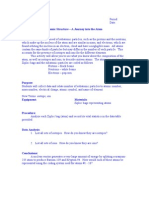1850928928531-535 - H. M. Nafees - SS - UET - PAID
1850928928531-535 - H. M. Nafees - SS - UET - PAID
Uploaded by
Eva BagaCopyright:
Available Formats
1850928928531-535 - H. M. Nafees - SS - UET - PAID
1850928928531-535 - H. M. Nafees - SS - UET - PAID
Uploaded by
Eva BagaOriginal Description:
Original Title
Copyright
Available Formats
Share this document
Did you find this document useful?
Is this content inappropriate?
Copyright:
Available Formats
1850928928531-535 - H. M. Nafees - SS - UET - PAID
1850928928531-535 - H. M. Nafees - SS - UET - PAID
Uploaded by
Eva BagaCopyright:
Available Formats
Sci.Int.
(Lahore),27(1),531-535,2015 ISSN 1013-5316; CODEN: SINTE 8 531
IMPACT OF JOB BURNOUT ON THE IN-ROLE PERFORMANCE OF FRONT-
LINE EMPLOYEES: A CASE OF BANKS IN LAHORE
*H. M. Nafees1, S. Kanwal1, M. Shoaib1
1
Institute of Business and Management Sciences, UET, Lahore
*Corresponding author’s email: mnafees74@yahoo.com
ABSTRACT: The structure of In-role performance impacts the job performance and productivity of employees, which
highlights the need to study various factors affecting in-role performance.Due toits negative impactonorganizational
performance, job burnout has become a developingconcernin many organizations particularly in evolvingcountries. This study
has examined the effect of Job burnout on in-role performance. Quantitative research methodology and convenience sampling
study were used.Data was collected by distributing questionnairestoservice employees of four top banks in Lahore. Statistical
package for social science was used to test the proposed hypotheses in the conceptual framework.The results of this study
indicated that exhaustion and disengagement had a moderate negative impact on in-role performance. This study provides
useful insights to the top management reduce burnout among employees.
KEYWORDS: Exhaustion,Disengagement, In-role performance, Job Burnout, Service employees
INTRODUCTION [23-24-25-26]. Likewise, disengagement represents a major
Generally combined with professionals usually and largely and deep reaction in terms of an emotional, cognitive, and
working in care-giving and helping occupation in the public behavioural rejection of the job. It is an occupational
sector [1], burnout appears in all kinds of jobs ranging from disillusionment [27]. Disengagement is defined as
health care [2], fire fighting [3], service jobs which have “distancing oneself from one’s work, and experiencing
boundary spanning roles [4-5-6] to those in banking sector negative behaviour toward the work object, work content, or
[7]. In-role performance refers to employees’ behaviours that one’s work in general” [28].
contribute to the effectiveness, success and overall In today’s increasingly competitive and aggressive banking
organizational performance [8]. In this regard, [9] offer three environment, competent bank executives view retention of
possible explanations for the influence and effectiveness of motivated, satisfied, and committed service employees
burnout on performance. First, burnout is characterized by a important to business success. It is also considered vital for
reduction and contraction of the available energy and the customer satisfaction and retention [29]. This is because
amount of effort that is invested to perform well. Second, service employees are a critical link in the provision of
employees with burnout get trapped and captured in a important services to customers and their actions are also
negative and vicious cycle, in which they are not inclined to essential for service recovery and improvements during the
search for support or are not motivated to change their time of service failure [30]. Service employees have been
situation, as a consequence their performance declines [10]. recommended as supporters to build trust and positively
Finally, burnout sabotage employees’ self-confidence in their impact customer’s attitudes and behaviours [31]. Service
ability to solve work related issues and problems. It is not employees often suffer from burnout[32]. With the economic
only a serious issue in itself but also results in reduction of development, agricultural sector has been transformed to
individuals’ valuable physical, emotional, sentimental, and manufacturing sector and presently, a shift to the service
intellectual strength as well as resources [11]. sector is noted [33-34-35]. In context of Pakistan, over the
Burnout is a psychological response to stressors on job [12] time period, contribution and division of services are
and leads to undesirable outcomes such as decreased job increasing in all sectors of economy, whereas the proportion
performance, job dissatisfaction, shifting of time spent on of service sector has extended from 39 percent of GDP in
work-related activities to non-work activities, depression, 1960-61 to 53.3 percent of GDP in 2009-10, therefore service
discouragement, lower organizational commitment, increased sector i.e. banking and business is the largest contributor in
absenteeism and turnover intentions [13-14-15-16-17-18]. the GDP of Pakistan [36].
Past researches show that the important dimensions of job Existing research shows that a lot of work has been done on
burnout i.e. exhaustion and disengagement from work can be in-role performance and job burnout within the context of
observed in essentially any occupational group [19-20-21]. foreign countries and business settings. However, there is still
Moreover, [22] define exhaustion as an extreme form of a gap in literature from Pakistan. Grounded in this view, the
weakness caused by prolonged disclosure to specific working aim of this study has been to examine the effect of job
conditions. It also refers to “results of intensive physical, burnout on service employees’ job performance of service
affective, and emotional pressures, for example as a long- employees in four top banks of Pakistan.
term consequence of extended exposure to certain demands”
532 ISSN 1013-5316; CODEN: SINTE 8 Sci.Int.(Lahore),27(1),531-535,2015
MATERIAL AND METHODS
The above discussed literature leads to the development of following conceptual framework shown in figure-1.
Job Burnout
H1
Exhaustion
In-role performance
Disengagement
H2
Control Variables
Gender
Age
Designation
Education
Income
Experience
Figure -1 Proposed Conceptual Framework
Hypotheses: Table-1.Variables and their measurement
Following hypotheses were established to test the impact of Sr. Variables Authors No. of
job burnout on in-role performance of front line employees No. Items
working in Lahore branches of banks in Pakistan: 1 Job Burnout
H1: Exhaustion has a significant negative impact on in-role
(a) Exhaustion [38-39-40-41] 7
performance.
H2: Disengagement has a significant negative impact on in- (b) Disengagement [42-43-44] 8
role performance.
Data for this study was collected from the service employees 2 In-role [4546-47-48] 4
who were in boundary spanning rolesandwereemployed in Performance
the Lahore branches of top four banks of Pakistan.
Convenience sampling was used due to the fact that an RESULTS AND DISCUSSION
reliable list of service employees working in the top four Demographics such as gender, age, designation, educational
banks of Pakistan was not accessible. Data was collected by qualification, income and experience were taken as control
distributing 360 questionnaires to front-line employees. A variables in this study. The percentage of respondents with
total of 310 questionnaires were returned with 86% response respect to each demographic is provided in table 2 given
rate,where 37 questionnaires were removed due to the below.
missing data and remaining 273 questionnaires were used for In addition, suppositions like normality, homoscedasticity
analysis.For getting accurate results all the respondents were and multicolinearity were checked before implementing
made sure of confidentiality. To carry out this research a multiple regression analysis. The variance inflation factor
combination of approved and authorized questionnaires was (VIF) test as well as tolerance level demonstrated a value less
adopted from the previous studies.Total 19 items were than 0.10; therefore, no issue of multicolinearity was detected
present in the questionnaire on a five point Likert scale from based upon the guidelines provided by [37]. Moreover, all
1 (Strongly Disagree) to 5 (Strongly Agree).The segregation values for correlation were significant at level p<0.01.
is shown in table 1 given below. The values of Cronbach’s According to the table 3, there existed a moderate negative
alpha for exhaustion, disengagement and in-role performance relationship between the two dimensions of job burnout;
were α=0.778, α=0.780, α=0.831 and were thus proved exhaustion (E123) and disengagement (D123) as well as in-
reliable. Furthermore, SPSS 18 was used to calculate scale role performance of employees. The correlation table also
reliability, Pearson product moment correlation and multiple proved the absence of multicolinearity with value of
regression. coefficients of independent variables was less than 0.70.
Sci.Int.(Lahore),27(1),531-535,2015 ISSN 1013-5316; CODEN: SINTE 8 533
Table-2.Characteristics of the respondents disengagement (D123) on in-role performance (IP123) with a
Characteristics of the confidence level of 100%. This result also proved the second
respondents Frequency Percentage hypothesis of this paper (H2) which stated that
Disengagement has a significant negative impact on in-role
Gender performance.In addition, R2 value was 0.301 at p=0.000
Female 107 39.2 denoting a 30.1% variance in the in-role performance (IP123)
Male 166 60.8 by exhaustion (E123) and disengagement (D123), while the
Age remainingimpact wasinstigated by other variables in Pakistani
culture which have not been taken into consideration in this
18-29 years 56 20.5
study.
30-39 years 132 48.4 Table-4.Coefficients of regression analysis
>40 years 85 31.1 Model B Std. Beta T Sig.
Error
Educational Qualification
Constant 5.058 .315 16.053 .000
Graduate 99 36.3
Masters 144 52.7 E123 -.175 .081 -.131 -2.153 .032
Others 30 11.0
D123 -.615 .081 -.461 -7.600 .000
Designation
Accounts Officer 24 8.8 Gender -.123 .099 -.066 -1.244 .215
Customer service officer 29 10.6
Age -.003 .084 -.022 -.037 .970
Cashier/shop floor 41 15.0
Operational manager 49 17.9 Designation .015 .026 .036 .575 .566
Consumer banking officer 42 15.4
Education .195 .093 .137 2.098 .037
Credit in charge 30 11.0
Manager 28 10.3 Income .025 .066 .025 .375 .708
General banking Officer 22 8.1
Experience -.085 .074 -.080 -1.159 .248
Other 8 2.9
N=273 R2=30.1
Table-3. Pearson correlation coefficients F=14.207
a. Dependent variable: IP123, Significant at 0.000 level
Variables E123 D123 IP123
Therefore, it is confirmed that job burnout leads to
E123 1
undesirable results like decreased in-role performance of
employees in banks of Pakistan. These results were consistent
D123 .517** 1 with the researches of [49-50-51-52-53-54].
IP123 -.354** -.519** 1 CONCLUSION
This study was carried out to analyse the impact of
**. Correlation is significant at the 0.01 level (2-tailed). exhaustion and disengagement on in-role performance of
N=273 service employees from top banks in Lahore. The results of
E= Exhaustion, D= Disengagement, IP= In-role this study indicated a moderate negative influence of
Performance exhaustion and disengagement on in-role performance. With
The basic purpose of this research was to judge that how this result, our all hypotheses for this study were proved, well
much the independent variable i.e. Job Burnout predicted the supported and sustained. Furthermore, it is verified that
dependent variable i.e. In-role performance. Table 4 managers in banks should discover the methods to lessen
displayed the values of regression analysis for the variables exhaustion and disengagement, which in turn improves the
included. It showed that the dimensions of independent in-role performance of service employees. To cope up with
variable i.e. job burnout, exhaustion (E123) and the reduced burnout among front-line employees, vacations,
disengagement (D123) had a moderate negative effect on in- employee counselling and training on stress management etc
role performance (IP123) at 100% confidence level. may be provided by banks. Moreover, managers should
Moreover, value of Beta (β= -.175) with a level of consider the personality attributes of the candidates during
significance p= 0.000 indicated that exhaustion (E123) the process of employee screening, selection, and hiring.
significantly and negatively influenced in-role performance However, the process of customers' evaluation of employee
(IP123) at 100% confidence level. This proved our first performance is equally important, as it explains the process
hypothesis (H1)that Exhaustion has a significant negative by which feedback and assessment may be related to
impact on in-role performance. In the similar way, coefficient customers' reaction of how the organization is performing.
of disengagement (D123) was β= -.615 and significant at
p=0.000. This proved a substantial negative impact of
534 ISSN 1013-5316; CODEN: SINTE 8 Sci.Int.(Lahore),27(1),531-535,2015
LIMITATIONS AND DIRECTIONS FOR FUTURE [13]. Shirom, A. Job-related burnout: A review. In J. C.
RESEARCH Quick and L. E. Tetrick (Eds.), Handbook of
Although the results reported here are significant, our occupational health psychology. Pp 245–264.
findings must be mitigated by certain limitations.The results Washington, DC, US: American Psychological
of this study can be applied only on one city of Pakistan i.e Association (2003).
Lahore thatlimits its generalizability. The design of this study [14]. Yagil, D. The relationship of service provider power
is used in this research cross sectional but not longitudinal. motivation, empowerment and burnout to customer
Apart from the two variables included in this paper, there are satisfaction. International Journal of Service Industry
several more variables which can influence in-role Management, 17(3), 258–270.
performance and those additional variables can be explored doi:10.1108/09564230610667104 (2006).
and incorporated in future researches. In addition, mediating [15]. Bhanugopan, R., and Fish, A. An empirical
and moderating effects may also be examined further. investigation of job burnout among expatriates.
REFERENCES Personnel Review., 35(4): 449–468 (2006).
[1]. Shirom, A. Job-related burnout: A review. In J. C. Quick [16]. Lewin, J. E., & Sager, J. K. A process model of burnout
and L. E. Tetrick (Eds.), Handbook of occupational among salespeople: Some new thoughts. Journal of
health psychology. Pp 245–264. Washington, DC, US: Business Research, 60(12), 1216–1224.
American Psychological Association (2003). doi:10.1016/j.jbusres.2007.04.009 (2007).
[2]. Cropanzano, R., Rupp, D. E., & Byrne, Z. S. The [17]. Podsakoff, N. P., LePine, J. A., & LePine, M. A.
relationship of emotional exhaustion to work attitudes, Differential challenge stressor-hindrance stressor
job performance, and organizational citizenship relationships with job attitudes, turnover intentions,
behaviors. Journal of Applied Psychology, 88(1), 160– turnover, and withdrawal behavior: A meta-analysis.
169. doi:10.1037/0021-9010.88.1.160 (2003). Journal of Applied Psychology, 92(2), 438–454.
[3]. Halbesleben, J. R. ., and Bowler, W. Emotional doi:10.1037/0021-9010.92.2.438 (2007).
exhaustion and job performance: the mediating role of [18]. Shani, A., and Pizam, A. Work-Related Depression
motivation., 92(1): 93–106 (2007). among Hotel Employees. Cornell Hospitality Quarterly,
[4]. Mulki, J. P., Jaramillo, F., & Locander, W. B. Emotional 50(4): 446–459 (2009).
exhaustion and organizational deviance: Can the right [19]. Leiter, M. P., and Schaufeli, W. B. Consistency of the
job and a leader’s style make a difference? Journal of burnout construct across occupations. Anxiety, Stress
Business Research, 59(12), 1222–1230. and amp; Coping, 9(3): (1996).
doi:10.1016/j.jbusres.2006.09.001 (2006) [20]. Demerouti, E., Bakker, A. B., Nachreiner, F., and
[5]. Yagil, D., Luria, G., and Gal, I. Stressors and resources in Schaufeli, W. B. The job demands-re-sources model of
customer service roles: exploring the relationship burnout., 86: 499–512 (2001).
between core self-evaluations and burnout, 19(5): 575– [21]. Bakker, A. B., Demerouti, E., & Schaufeli, W. B. The
95 (2008). validity of the Maslach Burnout In-ventory—General
[6]. Shani, A., and Pizam, A. Work-Related Depression survey: An Internet study. Anxiety, Stress, and Coping,
among Hotel Employees. Cornell Hospitality Quarterly, 245–260 (2002).
50(4): 446–459 (2009). [22]. Demerouti, E., Bakker, A. B., Vardakou, I., & Kantas,
[7]. Babakus, E., Yavas, U., & Ashill, N. J. The Role of A. The convergent validity of two burnout instruments:
Customer Orientation as a Moderator of the Job A multitrait-multimethod analysis. European Journal of
Demand–Burnout–Performance Relationship: A Psychological Assessment, 19(1), 12–23.
Surface-Level Trait Perspective. Journal of Retailing, doi:10.1027//1015-5759.19.1.12 (2003).
85(4), 480–492. doi:10.1016/j.jretai.2009.07.001 [23]. Demerouti, E., Bakker, A. B., Nachreiner, F., and
(2009). Schaufeli, W. B. The job demands-re-sources model of
[8]. Campbell, J. P. Modeling the performance prediction burnout., 86: 499–512 (2001).
problem in industrial and organizational psychology (In [24]. Aronson, E., Pines, A. M., and Kafry, D. Aus-gebrannt.
M. D. Dunnette, and L. M. Hough.). Consulting Vom Überdruß zur Selbstentfaltung. [Burnout: From
Psychologists Press (1990). tedium to personal growth] (1983).
[9]. Singh, J., Goolsby, J. R., and Rhoads, G. K. Behavioral [25]. Lee, R. T., & Ashforth, B. E. A further examination of
and psychological consequences of boundary spanning managerial burnout: Toward an integrated model.
burnout for customer service representatives., 31: 558– Journal of Organizational Behavior, 14(1), 3–20.
569 (1994). doi:10.1002/job.4030140103(1993).
[10]. Bakker, A. B., Demerouti, E., and Verbeke, W. Using [26]. Shirom, A. Burnout in work organizations. In C. L.
the Job Demands-Resources model to predict burnout Cooper and I. T. Robertson (Eds.), International review
and performance., 43(3): 83–104 (2004). of industrial and organizational psychology 1989. Pp
[11]. Halbesleben, J. R. ., and Bowler, W. Emotional 25–48. Oxford, England: John Wiley and Sons (1989).
exhaustion and job performance: the mediating role of [27]. Freudenberger, H. J. Staff Burn-Out. Journal of Social
motivation., 92(1): 93–106 (2007). Issues, 30(1), 159–165. doi:10.1111/j.1540-
[12]. Leiter, M. ., and Maslach, C. Banishing Burnout: Six 4560.1974.tb00706.x (1974).
Strategies for Improving Your Relationship with Work
(2005).
Sci.Int.(Lahore),27(1),531-535,2015 ISSN 1013-5316; CODEN: SINTE 8 535
[28]. Demerouti, E., Bakker, A. B., Nachreiner, F., and [37]. Pallant, J. SPSS survival manual: A step by step guide
Schaufeli, W. B. The job demands-re-sources model of to data analysis using SPSS for windows (version. 12).
burnout., 86: 499–512 (2001). NSW: Australia. Allen and Unwin (2005).
[29]. Yavas, U., Babakus, E., & Ashill, N. J. Testing a branch [38]. Demerouti, E., Bakker, A. B., Nachreiner, F., and
performance model in a New Zealand bank. Journal of Schaufeli, W. B. The job demands-re-sources model of
Services Marketing, 24(5), 369–377. burnout., 86: 499–512 (2001).
doi:10.1108/08876041011060477 (2010). [39].
[30]. Yavas, U. How similar are frontline bank employees’ [49]. Shirom, A. Job-related burnout: A review. In J. C.
perceptions of service quality to their customers? A Quick and L. E. Tetrick (Eds.), Handbook of
study of female customers and employees in Turkey. occupational health psychology. Pp 245–264.
Journal of Financial Services Marketing, 12(1), 30–38. Washington, DC, US: American Psychological
doi:10.1057/palgrave.fsm.4760062 (2007). Association (2003).
[31]. Colton, S., and Oliveira, P. Banking on It: the Role of [50]. Yagil, D. The relationship of service provider power
the Corporate Brand in Rebuilding Trust. Interbrand: motivation, empowerment and burnout to customer
Creating and Managing Brand Value. Retrieved from satisfaction. International Journal of Service Industry
www. interbrand.com/Libraries/Articles/- Management, 17(3), 258–270.
1_IP_Banking_on_it_pdf.sflb.ashx (accessed 17 January doi:10.1108/09564230610667104 (2006).
2011) (2009). [51]. Bhanugopan, R., and Fish, A. An empirical
[32]. Babakus, E., Yavas, U., & Ashill, N. J. The Role of investigation of job burnout among expatriates.
Customer Orientation as a Moderator of the Job Personnel Review., 35(4): 449–468 (2006).
Demand–Burnout–Performance Relationship: A [52]. Lewin, J. E., & Sager, J. K. A process model of burnout
Surface-Level Trait Perspective. Journal of Retailing, among salespeople: Some new thoughts. Journal of
85(4), 480–492. doi:10.1016/j.jretai.2009.07.001 Business Research, 60(12), 1216–1224.
(2009). doi:10.1016/j.jbusres.2007.04.009 (2007).
[33]. Clark, C. The conditions of economic progress (1941). [53]. Podsakoff, N. P., LePine, J. A., & LePine, M. A.
[34]. Kuznets, S. Quantitative aspects of the economic Differential challenge stressor-hindrance stressor
growth of nations: II. industrial distribution of national relationships with job attitudes, turnover intentions,
product and labor force. Economic Development and turnover, and withdrawal behavior: A meta-analysis.
Cultural Change., 5(4):1–111 (1957). Journal of Applied Psychology, 92(2), 438–454.
[35]. Fuchs, V. R. Economic Growth and the Rise of Service doi:10.1037/0021-9010.92.2.438 (2007).
Employment (Working Paper No. 486). National [54]. Shani, A., and Pizam, A. Work-Related Depression
Bureau of Economic Research. Retrieved from among Hotel Employees. Cornell Hospitality Quarterly,
http://www.nber.org/papers/w0486 (1980). 50(4): 446–459 (2009).
[36]. Ahmed, A., and Ahsan, H. Contribution of Services
Sector in the Economy of Pakistan (2011).
You might also like
- ISO 14001 ChecklistDocument10 pagesISO 14001 Checklistayman100% (3)
- Factors Affecting Job Satisfaction of EngineersDocument35 pagesFactors Affecting Job Satisfaction of Engineerslingg8850% (2)
- Research Significance: 79 Revista Iberoamericana de Psicología Del Ejercicio y El Deporte. Vol. 18, Nº 1 (2023)Document8 pagesResearch Significance: 79 Revista Iberoamericana de Psicología Del Ejercicio y El Deporte. Vol. 18, Nº 1 (2023)Motasim ShahinNo ratings yet
- Universiti Sains Malaysia: Kamalesh Ravesangar Rajendran MuthuvelooDocument20 pagesUniversiti Sains Malaysia: Kamalesh Ravesangar Rajendran MuthuvelooAzwanie MonastNo ratings yet
- The Effects of Commitment, Competence, Work Satisfaction On Motivation, Jurnal InternasionalDocument19 pagesThe Effects of Commitment, Competence, Work Satisfaction On Motivation, Jurnal InternasionalJoshua RingoNo ratings yet
- Employee Motivation As A Tool To Achieve Sustainability of Business ProcessesDocument15 pagesEmployee Motivation As A Tool To Achieve Sustainability of Business ProcessesAnonymous X3PnFL6No ratings yet
- Competancy Mapping Od Intervention: T Tests Descriptive Statistics DescriptionsDocument63 pagesCompetancy Mapping Od Intervention: T Tests Descriptive Statistics Descriptionsatlas77No ratings yet
- Welfare and Safety MeasuresDocument5 pagesWelfare and Safety Measuresரவிக்குமார் பகுத்தறிவாளன்No ratings yet
- Print 2Document9 pagesPrint 2Rajiv SinghNo ratings yet
- Stat Research Paper FinalDocument42 pagesStat Research Paper Finalviaborrez.dswdNo ratings yet
- Chapter FiveDocument82 pagesChapter FivebalujkNo ratings yet
- Impact of Employee Turnover On Organisational Effectiveness in Tele Communication Sector of PakistanDocument9 pagesImpact of Employee Turnover On Organisational Effectiveness in Tele Communication Sector of PakistanManpreet Kaur VirkNo ratings yet
- Anggita Wardani, Sulaksono, Hidayah - 2024 - Influence of Compensation, Work Discipline, Work Motivation, Work Loyalty and Work EnvironmDocument11 pagesAnggita Wardani, Sulaksono, Hidayah - 2024 - Influence of Compensation, Work Discipline, Work Motivation, Work Loyalty and Work EnvironmTaufan Arijadi GintingNo ratings yet
- The Impact of Work Life Balance On Employee Performance With Reference To Telecommunication Industry in Sri Lanka: A Mediation ModelDocument30 pagesThe Impact of Work Life Balance On Employee Performance With Reference To Telecommunication Industry in Sri Lanka: A Mediation Modelahmed mohyNo ratings yet
- The Influence of Motivation, Incentives, and Work Environment On The Performance of Civil Servants (Study at UPTB-UPPD / SAMSAT Whole Lombok Island Scope of BAPPENDA NTB Province)Document6 pagesThe Influence of Motivation, Incentives, and Work Environment On The Performance of Civil Servants (Study at UPTB-UPPD / SAMSAT Whole Lombok Island Scope of BAPPENDA NTB Province)AJHSSR JournalNo ratings yet
- Impact of Job Stress of Employees On Job Satisfaction in Telecom IndustryDocument43 pagesImpact of Job Stress of Employees On Job Satisfaction in Telecom IndustryPratya MishraNo ratings yet
- Review of LiteratureDocument6 pagesReview of LiteratureSylve SterNo ratings yet
- Ansu A - SynopsisDocument6 pagesAnsu A - SynopsisDrVijaya BaskaranNo ratings yet
- Employee Empowerment, Job SatiDocument21 pagesEmployee Empowerment, Job SatiAmrithaNo ratings yet
- Role of Human Resource Practices in Employee Performance and Job Satisfaction With Mediating Effect of Employee EngagementDocument17 pagesRole of Human Resource Practices in Employee Performance and Job Satisfaction With Mediating Effect of Employee EngagementDesynta Rahmawati GunawanNo ratings yet
- Document 115Document9 pagesDocument 115517wangyiqiNo ratings yet
- Haider Ali ThesisDocument16 pagesHaider Ali ThesisDanish AliNo ratings yet
- International Journal of HR and Social ScienceDocument13 pagesInternational Journal of HR and Social ScienceFakhrul IslamNo ratings yet
- Fuzzy Systems Are Extensively Used in BoDocument4 pagesFuzzy Systems Are Extensively Used in Bosilesh gizachewNo ratings yet
- HR marsDocument12 pagesHR marsTuyết Nhi Nguyễn ThịNo ratings yet
- Structural Equation Model On Work Engagement Among Hotel Employees in Region XI, PhilippinesDocument10 pagesStructural Equation Model On Work Engagement Among Hotel Employees in Region XI, PhilippinesThe IjbmtNo ratings yet
- Influence of LeadershipDocument15 pagesInfluence of LeadershipHenry DP SinagaNo ratings yet
- Suman DeviDocument9 pagesSuman DeviNaveen KumarNo ratings yet
- Ms. Abeer Imam, Dr. Muhammad ShafiqueDocument15 pagesMs. Abeer Imam, Dr. Muhammad ShafiqueLata SinghNo ratings yet
- Job Satisfaction of Bank Officers in Bangladesh: Nazrul IslamDocument13 pagesJob Satisfaction of Bank Officers in Bangladesh: Nazrul IslamMashnun HabibNo ratings yet
- Impact of Job Stress On Employee Performance: Research PaperDocument21 pagesImpact of Job Stress On Employee Performance: Research PaperShaheena SanaNo ratings yet
- The Impact of Employee Satisfaction On Quality and ProfitabilityDocument42 pagesThe Impact of Employee Satisfaction On Quality and ProfitabilityRoxana GrigorasNo ratings yet
- EconomicsDocument15 pagesEconomicsSisay tadeleNo ratings yet
- A Study On Flexible Working Condition and It'S Impact On Performance and Job Satisfaction at DatazoicDocument6 pagesA Study On Flexible Working Condition and It'S Impact On Performance and Job Satisfaction at DatazoicJohnfani ManyakaNo ratings yet
- Performance Appraisal of Employees in Textile Industries in KozhikodeDocument6 pagesPerformance Appraisal of Employees in Textile Industries in Kozhikodemynguyen291001No ratings yet
- The Effect of Supervision Levels On Employees' Performance LevelsDocument5 pagesThe Effect of Supervision Levels On Employees' Performance LevelsOktri AnsyahNo ratings yet
- Reward SystemDocument53 pagesReward SystemNininahazwe Oscar67% (3)
- LavanyapaperpublishedDocument15 pagesLavanyapaperpublishedpryash gajadinNo ratings yet
- A Review On Effects and Challenges of Staff RetrenDocument10 pagesA Review On Effects and Challenges of Staff RetrenManish SinghNo ratings yet
- Job Satisfaction of Bank Officers in Bangladesh: Nazrul IslamDocument13 pagesJob Satisfaction of Bank Officers in Bangladesh: Nazrul IslamZarin Ahmed ProtikshaNo ratings yet
- Impact of Job Stress On Employee Performance: Research PaperDocument21 pagesImpact of Job Stress On Employee Performance: Research PaperᎷᏒ'ᏴᎬᎪᏚᎢ ᎷᏒ'ᏴᎬᎪᏚᎢNo ratings yet
- Motivational Factors and Its Influence o 82277014Document16 pagesMotivational Factors and Its Influence o 82277014sundayohabuenyiNo ratings yet
- Factors Influencing Employee Engagement by Kimberly AlesnaDocument9 pagesFactors Influencing Employee Engagement by Kimberly AlesnaKimaii AlesnaNo ratings yet
- Work Life Balance of Employees and Its Effect On Work Related Factors in Nationalized BanksDocument8 pagesWork Life Balance of Employees and Its Effect On Work Related Factors in Nationalized BanksPrakaash RaajNo ratings yet
- Comparative Study of Quality of Work Life in Private Sector and Public Sector BanksDocument16 pagesComparative Study of Quality of Work Life in Private Sector and Public Sector BanksprpNo ratings yet
- Work Life Balance Among Non-Teaching Staff in Self-Financing Colleges in TamilnaduDocument5 pagesWork Life Balance Among Non-Teaching Staff in Self-Financing Colleges in TamilnaduEditor IJTEMTNo ratings yet
- Case Study PMDocument28 pagesCase Study PMyogaknNo ratings yet
- Chapter 7Document10 pagesChapter 7Yazhni ChinnaduraiNo ratings yet
- Consequences of Performance Appraisal Experiences On HRM OutcomesDocument22 pagesConsequences of Performance Appraisal Experiences On HRM OutcomesSobia MurtazaNo ratings yet
- Job Satisfaction of Bank Officers in BangladeshDocument13 pagesJob Satisfaction of Bank Officers in BangladeshDr. Nazrul IslamNo ratings yet
- Effect of Training On Employee Performance: An Empirical Study On Telecommunication Industry in BangladeshDocument14 pagesEffect of Training On Employee Performance: An Empirical Study On Telecommunication Industry in Bangladeshfareha riazNo ratings yet
- Nayak 2015Document12 pagesNayak 2015Abirami DurairajanNo ratings yet
- Assessing The Implications of Job Satisfaction Towards Employee Performance: Insights From Public Servant Professionals (PSPS)Document19 pagesAssessing The Implications of Job Satisfaction Towards Employee Performance: Insights From Public Servant Professionals (PSPS)Tessalonika RorettaNo ratings yet
- A Study On Quality of Work Life of Employees of Power Sector With Special Reference To Working ConditionsDocument6 pagesA Study On Quality of Work Life of Employees of Power Sector With Special Reference To Working ConditionsJAYANT SINGHNo ratings yet
- Impact of supervisory behavior on sustainable employee performanceDocument21 pagesImpact of supervisory behavior on sustainable employee performanceAvia MariaNo ratings yet
- REVIEW Summary1Document6 pagesREVIEW Summary1belachew guwisoNo ratings yet
- A Study On Job Satisfaction of Employees in Public Sector Banks in KarnatakaDocument7 pagesA Study On Job Satisfaction of Employees in Public Sector Banks in Karnatakabipin8055bipinNo ratings yet
- The Effect of Mutation, Promotion and Job Satisfaction On Employee Performance of Plantation Companies in MedanDocument11 pagesThe Effect of Mutation, Promotion and Job Satisfaction On Employee Performance of Plantation Companies in MedanaijbmNo ratings yet
- Sundus ButtDocument57 pagesSundus ButtIshtiaqNo ratings yet
- Employee Engagement in Contemporary Organizations: Maintaining High Productivity and Sustained CompetitivenessFrom EverandEmployee Engagement in Contemporary Organizations: Maintaining High Productivity and Sustained CompetitivenessNo ratings yet
- Liver & Gall Bladder: Presented by DR - Sujaya NairDocument102 pagesLiver & Gall Bladder: Presented by DR - Sujaya Nairjoy rajNo ratings yet
- What Is Management Accounting and Its Functions?Document2 pagesWhat Is Management Accounting and Its Functions?ritu paudelNo ratings yet
- 14 Questions About Imam-e-Zamaana (A.t.f.s.)Document24 pages14 Questions About Imam-e-Zamaana (A.t.f.s.)Akbar Ali KhanNo ratings yet
- Selected Srimad-Bhagavatam VersesDocument10 pagesSelected Srimad-Bhagavatam VersesVidvan Gauranga Dasa100% (1)
- MisDocument15 pagesMisRhea Mae Caramonte AmitNo ratings yet
- My First Presentation - SabaDocument20 pagesMy First Presentation - SabaSaba Abu FarhaNo ratings yet
- Business RulesDocument2 pagesBusiness RulesCosminaStancalaNo ratings yet
- Floefd Electronics Cooling ModuleDocument3 pagesFloefd Electronics Cooling ModuleEsen DilerNo ratings yet
- Summer Stay On Track Grades 2 To 3Document68 pagesSummer Stay On Track Grades 2 To 3Gabe Coron100% (4)
- 11.political Science XI PDFDocument3 pages11.political Science XI PDFRaminderjit KaurNo ratings yet
- Divine Mercy ImageDocument3 pagesDivine Mercy ImageSteve BoteNo ratings yet
- Format Of: (For The Students of BBA)Document9 pagesFormat Of: (For The Students of BBA)Swati DhingraNo ratings yet
- 03 Chapter+One+1984 Class+Work+25th+October+Period+4Document7 pages03 Chapter+One+1984 Class+Work+25th+October+Period+4oloop124No ratings yet
- Pharmacon Hubungan Komunikasi Interpersonal Dengan Tingkat Kecemasan Pasien Sebelum Tindakan Pencabutan Gigi Di RSGM FK UnsratDocument7 pagesPharmacon Hubungan Komunikasi Interpersonal Dengan Tingkat Kecemasan Pasien Sebelum Tindakan Pencabutan Gigi Di RSGM FK UnsratNanda WarizkyNo ratings yet
- Professional - Programming in Java - Trainer GuideDocument732 pagesProfessional - Programming in Java - Trainer GuidePrince AluNo ratings yet
- United States v. James Bushert, 997 F.2d 1343, 11th Cir. (1993)Document20 pagesUnited States v. James Bushert, 997 F.2d 1343, 11th Cir. (1993)Scribd Government DocsNo ratings yet
- 024 - Mercado Vs ManzanoDocument2 pages024 - Mercado Vs ManzanoPatrick ManaloNo ratings yet
- Partnership MatrixDocument2 pagesPartnership MatrixcharshumNo ratings yet
- Ali Baba and The Forty ThievesDocument5 pagesAli Baba and The Forty ThievesUncil StylerNo ratings yet
- Be A Master Speller: Follow The Rules: © White Educational ProductsDocument23 pagesBe A Master Speller: Follow The Rules: © White Educational Productsshaira alliah de castroNo ratings yet
- HOLIDAYS AND CELEBRATION - Angol TételDocument2 pagesHOLIDAYS AND CELEBRATION - Angol TételAlexa c:No ratings yet
- Chapter 17 Indian Constitution - Fundamental Rights and DutiesDocument3 pagesChapter 17 Indian Constitution - Fundamental Rights and Dutiesaaqibyt004No ratings yet
- Micro Piles For Structural DesignDocument25 pagesMicro Piles For Structural DesignPedro Cedeño100% (1)
- PTI Assignment 10Document1 pagePTI Assignment 10Jonathan WagnerNo ratings yet
- Study of Consumer Preferences To The Brand of Vadilal Ice CreamDocument10 pagesStudy of Consumer Preferences To The Brand of Vadilal Ice CreamAnil Kumar ShaooNo ratings yet
- Nelayan Tiku Tradisi Dan Kelembagaan Sosial BerdasDocument26 pagesNelayan Tiku Tradisi Dan Kelembagaan Sosial Berdashamja abdu halikNo ratings yet
- Cooking With Manuela Almond Swirl Pastries (Girelle Alle Mandorle)Document1 pageCooking With Manuela Almond Swirl Pastries (Girelle Alle Mandorle)zvqvwksvdzNo ratings yet
- 1857 Revolt PrintableDocument1 page1857 Revolt Printablekibaf56995No ratings yet
- Atomic Structure Lab 3Document2 pagesAtomic Structure Lab 308090311No ratings yet

